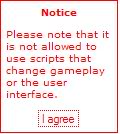-
 Sun 18th Jul 2010 08:22 #121 / 160
Sun 18th Jul 2010 08:22 #121 / 160
Gimli wrote: where is the bulk of the KESP discussion, where we can find answers on how 3 attacks on 1 territory would work?
This is an example of how I think a 3 v 1 attack might go down using KESP: I made it so that there is at least one step where its mechanics are unclear to me. Kjeld and I have discussed that certainly there will be issues to be resolved as these scenarios are examined in more depth.
A, B, and C all attack D. D isn’t attacking anyone.
We’ll use 50% dice and say that we get expected results.
All attacks are set to a “default†Kill Distribution of Even, and there are no retreat thresholds.
D’s stack has 15
A attacks D with 50 with a “default†even kill distribution.
B attacks D with 40
C attacks D with 20
Round 1: All armies find themselves on the same battlefield attacking D, so the engine “randomly†distributes their respective kills “evenly†per orders
A kills 25; 8B, 9C, 8D
B kills 20; 6A, 7C, 7D
C kills 10; 4A, 3B, 3D
D kills 7; 2A, 2B, 3C
A loses 12 armies with 38 standing
B loses 13 with 27 standing
C loses 19 with 1 standing
D is suppose to lose 18 but only has 15 to lose, so those extra three overkills get allocated to other players, but what’s fair?
If A, B, and C all made 6 dedicated D kills, then there would be no problem; the three extra kills would go one to each remaining player, but in this case C only killed three D armies and A and B took up the slack, so technically those overkills belong to them. In this particular case A made two more than necessary and B made one more than necessary. So those kills get re-allocated to the remaining stacks, again according the “even†distribution setting.
Now here’s where I think there’s a small issue. A’s two overkills go one to B and one to C. ..and let’s say for argument’s sake that B’s overkill gets "randomly" allocated to C as well. (But C only has 1 to lose!) I’m not sure how this is resolved. Some kind of a tie breaker has to apply here.
Let’s say somehow this gets resolved and A gets to re-allocate his re-allocated kill to B. So at the end of the round B and C are gone and A and B remain with 38 and 26 armies respectively. Then, because no retreat thresholds kick in, round 2 is resolved in straight-ahead 1 v 1 fashion, then round 3, etc..
..but we won't be completely happy until there is a "barren" designer feature.Edited Sun 18th Jul 08:23 [history]
-
 Sun 18th Jul 2010 15:37 #122 / 160
Sun 18th Jul 2010 15:37 #122 / 160
M-Engine
Concept: All players announce their orders for each and every territory they own in no particular order. All players then throw one round of attacking and/or defending dice as necessary for each pending battle. All rolls are simultaneously resolved, orders are revisited for conditions met, and the next round of rolls commences. The procedure is repeated in succeeding rounds until all orders have been exhausted.
Features:
- Simultaneous and continuous resolution of all orders regardless of intertwined attack configurations.
- Taking a turn feels very similar to regular play
- Uses standard “Risk†dice rules for attack and defense
- Observes all dice and border modifiers
- Can support multiple moves/attacks (blitzing).
Basic Description of Play:
Players take a “mock†turn on the board. The order in which they make their moves is not relevant because they will all occur concurrently. Players make their moves by giving armies orders to attack and advance and making additional orders for supporting armies to fall back in order to defend incoming attacks if necessary. A round consists of one set of rolls for every conflict on the board. All unresolved conflicts participate in the next round of rolls, and so on. When all orders have been exhausted, the turn ends and the next turn begins.
Orders:
An attack order consists of the following.
- # of attacking armies. (These armies are committed to attack and advance. They will attack until depleted or victorious)
- # of supporting troops that are capable of falling back. (These troops will be called forward to the front or back to defend the territory as necessary on a round by round basis).
- # of additional armies to advance if the battle is victorious (This number includes supporting armies).
Resolution of Standard Attack
Dice are simultaneously rolled for both players according to orders. Attack(s) proceed through succeeding rounds until all defending units have been defeated or Attacker’s armies are depleted. If all of the defender’s units have been defeated, current attack results from all other defender’s battles are then examined. Any supporting armies are then called back to defend the territory in the following round. The process is repeated as necessary in succeeding rounds.
Resolution of Multiple Attacks on a Single Territory
Dice are simultaneously rolled for all players according to orders. Defender’s single roll (be it with one or two dice) applies to all conflicts. All conflicts are then resolved against the territory’s defending dice only, where the defender’s maximum loses are allowed to be no larger than the number of dice defensive dice thrown. Attack(s) proceed as normal in succeeding rounds of rolls until defender is defeated or all attackers’ armies are exhausted.* In the case where the defender is defeated and there is still more than one player contesting the territory, attacks continue but rules for “Resolution of Multiple Attacks on an Unoccupied Territory†apply.
Resolution of Multiple Attacks on an Unoccupied Territory
All attacking players roll their max attack dice as usual. The highest dice from each player’s rolls are compared, then next highest if necessary, and lastly third highest if necessary. Ties result in no kills. All values lower than the high roll(s) at each "level" represent casualties. Thresholds are checked and the process is repeated in the next round of rolls until only one player is attacking. If all thresholds are simultaneously met AND the map doesn’t allow the territory to be abandoned, all thresholds are temporarily suspended one move/roll at a time until there is a victor.
There you have it.. The M-Engine. I think the simultaneous attack mechanism is simple to understand, yet robust.
If I understand phantom order stacking correctly, this engine is capable of creating a continuous "stack" of orders by making just one move. If enabled, by attacking your own territory, on every round the engine will check to see if it can execute the order. If the territory is being held by an enemy, an attack commences.
*It is actually possible to allow multiple and simultaneous attacks of one territory by one attacking player (all committed troops from both territories will advance).
Posts of various resolved attack configuration examples to come..
..but we won't be completely happy until there is a "barren" designer feature.Edited Sun 18th Jul 15:50 [history]
-
 Sun 18th Jul 2010 20:17 #123 / 160
Sun 18th Jul 2010 20:17 #123 / 160
Here's a page with the M-Engine description that has links to a few attack resolution examples.:
https://sites.google.com/site/m57sengine
By using the site, hopefully folks can get a pretty in-depth idea of how it works without having to hunt down a bunch of scattered posts, and it can be updated easily as any bugs are worked out.
Right now, I've only put up a few very basic scenarios that demonstrate how it works with basic configurations, but as I said, I think it'll hold up to any situation. So if there's a particular attack scenario that you think will break it, let me know and I'll try to put it up there.
-
 Sun 18th Jul 2010 23:12 #124 / 160
Current state of the M-Engine:
Sun 18th Jul 2010 23:12 #124 / 160
Current state of the M-Engine:Don't even bother to read post #122. Better to just go to the site. I've made quite a few updates..
https://sites.google.com/site/m57sengine/home
-
 Mon 19th Jul 2010 09:56 #125 / 160
Mon 19th Jul 2010 09:56 #125 / 160
My simple modification: During the "run" attacks phase add in a check that if a player attacks themselves, the attack will go through, but will count as a pre-transfer and the next attack from that same player will then commence until a real attack is reached or there are no more attacks from that player. Then, continue as before to the next player.
With this there is no reason to do phantom attacks, but the predictive element of reclaiming lost ground is there.Unfortunately this does not work. All a player has to do to get around it is do one "real" attack, and then start attacking themselves. It is pretty easy to see that it is too complicated to "check forward" past real attacks to try and turn attack phase transfers into pre-transfers.
BD
-
 Mon 19th Jul 2010 10:47 #126 / 160
Never Start Vast Projects With Half Vast Ideas.
Mon 19th Jul 2010 10:47 #126 / 160
Never Start Vast Projects With Half Vast Ideas.BlackDog wrote:
My simple modification: During the "run" attacks phase add in a check that if a player attacks themselves, the attack will go through, but will count as a pre-transfer and the next attack from that same player will then commence until a real attack is reached or there are no more attacks from that player. Then, continue as before to the next player.
With this there is no reason to do phantom attacks, but the predictive element of reclaiming lost ground is there.Unfortunately this does not work. All a player has to do to get around it is do one "real" attack, and then start attacking themselves. It is pretty easy to see that it is too complicated to "check forward" past real attacks to try and turn attack phase transfers into pre-transfers.
BD
Each round this check is made, so if on your fifth attack, you tried to predict where you would be broke and were wrong, this attack becomes a fortify and the next attack in your queue/stack happens.
I hesitate to give an example because it is too hard to do without a graphic.
-
 Mon 19th Jul 2010 11:35 #127 / 160
Mon 19th Jul 2010 11:35 #127 / 160
Ok, I think I see what you are saying, and it might work. However, this implies that you are also checking the number of armies in the territory being transfered to. If you are attacked but do not lose the territory, that would change the number of men who can be transfered, so clearly you could not turn that transfer into a pre-transfer.
-
 Mon 19th Jul 2010 11:37 #128 / 160
BAO alternative:
Mon 19th Jul 2010 11:37 #128 / 160
BAO alternative:Alpha and BlackDog.. What are you talking about? Tos BAO? I can't tell..
https://sites.google.com/site/m57sengine/home
-
 Mon 19th Jul 2010 11:39 #129 / 160
Never Start Vast Projects With Half Vast Ideas.
Mon 19th Jul 2010 11:39 #129 / 160
Never Start Vast Projects With Half Vast Ideas.M57 wrote: Alpha and BlackDog.. What are you talking about? Tos BAO? I can't tell..
Yes.
-
 Mon 19th Jul 2010 13:15 #130 / 160
BAO alternative:
Mon 19th Jul 2010 13:15 #130 / 160
BAO alternative:The M-Engine description page has been modified and updated with the following features:
- Simultaneous and continuous resolution of all orders regardless of intertwined and dynamically changing attack configurations
- Uses standard dice configurations and rules for attack and defense
- Observes all dice and border modifiers
- Integrated event-dependent orders eliminate the need for "phantom order stacking" and can be easily and quickly given
- Support for round-specific delayed orders
- Support for multiple moves/attacks (blitzing)
- Taking a turn feels very similar to regular play
https://sites.google.com/site/m57sengine/homeEdited Mon 19th Jul 13:26 [history]
-
 Thu 22nd Jul 2010 04:19 #131 / 160
Thu 22nd Jul 2010 04:19 #131 / 160
CiscoKid wrote:
So is anyone white boarding the logic flow for this?
I've read, considered, and tried my best to keep up. The game types break into two main classes:
1) "Traditional Blind-at-Once": Players take turns simultaneously by submitting orders, but the orders are not executed simultaneously.
2) Simultaneous: There are many phases, but in each phase the attacks are resolved simultaneously.
Scenarios in which the two differ are plentiful: Consider A attacks B and B attacks C. In BAO, if B times it so that A attacks first, B uses all armies on that country doing maximal damage to A's attacking force (and preventing A from taking the country), and then gets to use whatever remains to attack and potentially overtake C. In Simultaneous, B can't use the armies committed to attacking C to defend against A's attack.
In addition to the two main types, some interesting parameters such as fatigue and order limits have been suggested. These parameters could be applied to any of the game types (even to turn-based!) Suggestions leading to dramatically different gameplay include:
I) Diceless - achievable by setting the kill rate to 100%. Edges are obtained by being the one with the overwhelming force.
II) Blitzing - should an invasion succeed, an order following the invasion could be to continue onward to invade another country. This could be implemented in any of the game types.
My initial (probably wrong) understanding of the M-engine is something like: uses turn-based dice, but on the most abstract level it is essentially Kjeld's Simultaneous plus Blitzing.
The rest of the thread has been devoted to implementation details.
Edited Thu 22nd Jul 04:34 [history]
-
 Thu 22nd Jul 2010 06:16 #132 / 160
Thu 22nd Jul 2010 06:16 #132 / 160
Gimli wrote:
I remember when I started on warfish...
Account Created : 2007/08/15 07:47:57 There was no BAO activity that I can recall. Were there even BAO boards back then? I remember when BAO boards were coming out, I invited players I liked and who showed intellgence to BAO boards. It seemed a bit of a sell to complete new people. They'd join and complain. I had to include BAO warnings in the game names. Especially when I was getting people into Toaster's AnA.
Account created : 2006/08/14 13:12:24
We played BAO gameplay on the Malta map on 2006/08/19. Before all the great BAO boards, we just played it on plain old world maps.
It's definitely a tough sell. I don't think it's all that popular, though the same could be said of any turn-based board that doesn't look and play like Risk. I don't actually advocate BAO because it is familiar or popular, because it is neither. Not every BAO board is good just as not every turn-based board is. No, I advocate BAO because it birthed many truly excellent boards. These boards had the highest ratings on TOS not because they were popular, but because their devotees recognized the excellence. They are wonderful creations and you can't come close to reproducing them with turn-based or the other proposed simultaneous systems. The other systems will birth excellence too, but BAO deserves its own corner of the universe to exist in.
-
 Thu 22nd Jul 2010 06:45 #133 / 160
Mongrel: "Yeah, If 11s is not eliminated in the first 5 rounds - back to the drawing board." SO TRUE!
Thu 22nd Jul 2010 06:45 #133 / 160
Mongrel: "Yeah, If 11s is not eliminated in the first 5 rounds - back to the drawing board." SO TRUE!I've been thinking (always dangerous). There are really two parts to a BaO system. The first is how the battles are decided on the server once the last player to place orders clicks the OK button. I haven't kept up with the KESP / M-Engine discussions, but I've skimmed them and it seems that this is the part they are designed to tackle.
The second part is the actual player interface and what it is actually possible to do with your units in each country per turn. It's my humble opinion that this is horse that the M-engine cart is being put before, or at least the side-car the M-engine forgot to attach. (Where's RB? I need his super metaphor powers.)
I have some ideas for the second part but it's late, so instead I have a different suggestion. This thread is becoming as unwieldy as a Japanese Anime sword. Why don't we create the following sticky threads:
BaO - Poll. It would be nice to have a polling function but for now we can simply vote once: do you want the BaO system from the other site implemented first, or would you like an alternative system implemented first?
BaO Old Mod - The two aspects of this system are already established, this would be for discussing if any changes should be made to the order-stacking aspects of the system and what those changes should be (if any).
BaO New - Turn Resolution System - copy the links to M-Engine, KESP, discuss, try to break, and incorporate any good ideas from the last thread:
BaO New - Player Interface System - open a discussion about ways to add tactical complexity to the system by expanding the ability to control your units via the player during your turn. (i.e. Blitzing as posited by Hugh in his last post).
It might sound like overkill but this is an extremely popular topic and I really think we need to split it up in order to move things along.
-
 Thu 22nd Jul 2010 07:23 #134 / 160
BAO alternative:
Thu 22nd Jul 2010 07:23 #134 / 160
BAO alternative:Hugh, Did you check out the M-Engine website?
Consider A attacks B and B attacks C. In BAO, if B times it so that A attacks first, B uses all armies on that country doing maximal damage to A's attacking force (and preventing A from taking the country), and then gets to use whatever remains to attack and potentially overtake C. In Simultaneous, B can't use the armies committed to attacking C to defend against A's attack.
While there is some truth to this statement, it misrepresents one of the innovative and fundamental features of the M-Engine, although your choice of the word “committed†may be craftier than you realize. Yes, a single army can’t both attack and defend at the same time, but at the M-Engine “round†level it doesn’t have to unless the originating territory’s defensive stack gets too low. With the M-Eng, Flex armies are able to fall back on an “as needed†basis. Consider that B attacks C with 10 flex armies, and B is also being attacked by A. At the “round†level, B can only attack with 3 dice at a time so Flex armies will be able fall back and defend for at least a number of rounds. With M-E, a player can actually control the tactical disposition of their forces by attacking with a combination of “committed†attack armies and defensively "concerned" flex armies.
My initial (probably wrong) understanding of the M-engine is something like: uses turn-based dice, but on the most abstract level it is essentially Kjeld's Simultaneous plus Blitzing.
It’s semantics, but I would say the opposite. At the most abstract level, all methods simulate the execution of orders simultaneously. BaO sees the event-level time frame at the individual player battle level, KESP sees the event-level as all battles, and the M-Engine sees it at the individual die roll level.
https://sites.google.com/site/m57sengine/homeEdited Thu 22nd Jul 07:52 [history]
-
 Thu 22nd Jul 2010 07:26 #135 / 160
Give a man fire and he's warm for a day... but set him on fire and he's warm for the rest of his life.
Thu 22nd Jul 2010 07:26 #135 / 160
Give a man fire and he's warm for a day... but set him on fire and he's warm for the rest of his life.In Simultaneous, B can't use the armies committed to attacking C to defend against A's attack.
From what I understand, this is not true in M57's system. By assigning "flex" armies, they are able to do just that. Defend as necessary, but then surplus armies will attack as they are available.
And apparently M57 beat me to it. :P
Edited Thu 22nd Jul 07:27 [history]
-
 Thu 22nd Jul 2010 07:30 #136 / 160
BAO alternative:
Thu 22nd Jul 2010 07:30 #136 / 160
BAO alternative:..Vataro's got my back.

https://sites.google.com/site/m57sengine/home
-
 Thu 22nd Jul 2010 07:59 #137 / 160
Thu 22nd Jul 2010 07:59 #137 / 160
What I said is accurate in both Kjeld's simultaneous and in Andernut's Risk II description. My understanding of these was what I had in mind when referring to games that fall under the category "Simultaneous".
I suspected I was missing some important points with the M-engine. I did erroneously put the M-engine in the same category as Kjeld's system. I was replying to what looked like a summary request (for the entire thread, not for the M-engine) and hoped to have everything neatly categorized. I did visit your site, but I have not absorbed it.Edited Thu 22nd Jul 08:09 [history]
-
 Fri 23rd Jul 2010 12:54 #138 / 160
Fri 23rd Jul 2010 12:54 #138 / 160
For the record, I also liked how BAO did have a different attacking/dice system than Turn Based. The Base values and the way Wins and Losses were calculated helped distinguish BAO from Turn Based. (I think Kjeld's suggestion sticks somewhat close to this, although using 100 sided dice :p)
It may be more difficult to grasp, but it's a more unique gameplay than really just telling the system how to take your turn.
-
 Fri 23rd Jul 2010 15:54 #139 / 160
Fri 23rd Jul 2010 15:54 #139 / 160
Good point. Large forces do better in battles (even percentage-wise!!) than do smaller forces. In Kjeld's system there is no distinction between attacker/defender, but it can matter what direction you are coming from (ie border modifiers can influence kill rate). Otherwise it is similar.
-
 Mon 2nd Aug 2010 18:16 #140 / 160
asm wrote:
Mon 2nd Aug 2010 18:16 #140 / 160
asm wrote:I'm implementation-agnostic as far as this conversation goes, but I do want to chime in on what I think ToS BAO did well and what it didn't, with the hope that whatever we use here to match or exceed that functionality is at least as compelling:
Does Well...
- Limits "crab bucket" games, where the leader takes their turn, then everyone following the leader bashes the leader with cards, units, etc. Makes it much easier to keep a lead if you have one. It also makes larger maps playable, or at least keeps them from turning into interminable "wait for the cards to get big enough to roll over opponents' stacks" contests. Of course, fog accomplishes this too.
- Makes certain game types possible. One game I'd love to port over is Strategic Conquest, which is a fun little strategy game that'd be dirt simple to get going. Trouble is, in the original game, each unit had a set number of moves allocated to it, and you can't really simulate that with Risk-style mechanics. On the other hand, using BAO-style mechanics, it'd be fairly simple - everyone only moves once per turn anyway, so you just use vision modifiers to get "close enough". The result would be something similar to "Axis & Allies" from ToS - it'd be loosely similar to the original, but different enough to be compelling in its own right. Oh yeah - and you can actually do A&A-type games via BAO, while you really can't with Risk-style mechanics.
Does Poorly...- Turn order tedium bugged me too. I'm all for strategy and tactics, but "I'm going to move 1000 units in a giant circle, so I think my attack will hit last" vs. "I'm going to move 1001 units in a giant circle, so my attack actually will hit last" is not the sort of strategy or tactics that we should be encouraging. That's boring and tedious for all but the 1% of the gaming population with severe OCD.
Here's the thing - it shouldn't take you more than, oh, 10 minutes to mechanically complete a turn to your liking. It might take longer than that to decide on the best strategy, but it shouldn't take you over 10 minutes to complete the requisite number of mouse clicks. For asm-style BAO turns, even with high bandwidth, it would be physically impossible to do this using asm-style BAO turn stacking on all but the most trivial of BAO boards. That's not fun - it's tedious. Anything that can be done to minimize this is a good thing. Heck, from a practical standpoint, multiply that 10 minutes by 30 games, then tell me how many turns you're taking in a day. Good luck with that.
Following that criteria, having "blitz" orders would violate what, to me, was a big feature of BAO - it'd encourage crab bucket play. If you're going to have that, just play by the original rules so you can move on with your life. Plus, if you can do "blitz" orders, you're going to be able to traverse a sparsely populated map on your first turn because, no matter how high your "fatigue", X% of 1 is always greater than 0, which nukes the second benefit of BAO.Past that, though, I'm not seeing anything particularly objectionable. We just need to make sure that whatever system is implemented is easy enough to explain where it still makes sense without the use of set theory notation.
I... can't find anything wrong with this line of reasoning...














